Brief

Executive Summary
- More than 90% of surveyed Hong Kong and mainland China companies expect increasing turbulence from such calamities as epidemics and civil conflicts, as well as slower-burning disruptions such as emerging competition and capabilities.
- Still, most surveyed company secretaries agree that their firms are prepared for such challenges and are resilient to shocks.
- More than 90% of them believe effective stakeholder management improves financial results, but there’s room for improvement in the way companies engage with stakeholders.
- To help navigate increasing turbulence, boards can take seven actions to shift the balance of stakeholder and shareholder interests.
In an increasingly turbulent world, corporations face more disruptions, at a faster pace, than at any other time in living memory. Navigating this turbulence—and coming out the other side even stronger for it—is a priority for corporate boards. Predicting and assessing risk and proactively working to strengthen the organization’s resilience are vital tasks for forward-looking leaders. In Hong Kong and the Chinese mainland, corporate boards and leaders have an ally in this effort, in the form of the company secretary.
Few roles give employees greater insight into the needs and priorities of the corporations they serve. From ensuring that operations are fully compliant with statutory laws and regulations (per the Hong Kong Companies Ordinance) to providing advice and direction about the organization’s administration and governance and about industry trends and emergent markets, the company secretary plays a vital part in Hong Kong and mainland China companies’ ability to adapt and grow.
Company secretaries have a wide purview, working directly with regulators, shareholders, and boards of directors to develop and manage board governance and strategy. From this vantage point, company secretaries are in a unique position to help Hong Kong and mainland China’s corporate boards of directors respond to turbulence with a future-proof agenda.
To learn how Hong Kong and mainland China companies are approaching this era of turbulence, Bain & Company—in collaboration with The Hong Kong Institute of Chartered Secretaries—surveyed more than 1,400 company secretaries in Hong Kong and mainland China.
Navigating a world of heightened turbulence
Our world has become more turbulent than at any time in living memory, with disruptions increasing in frequency over the past two decades (see Figure 1). In the past 25 years alone, Hong Kong corporations have weathered the Asian financial crisis, the dot-com crash, a global financial crisis, the swine flu outbreak, a trade war with the United States, recent social unrest in Hong Kong, and the Covid-19 pandemic.
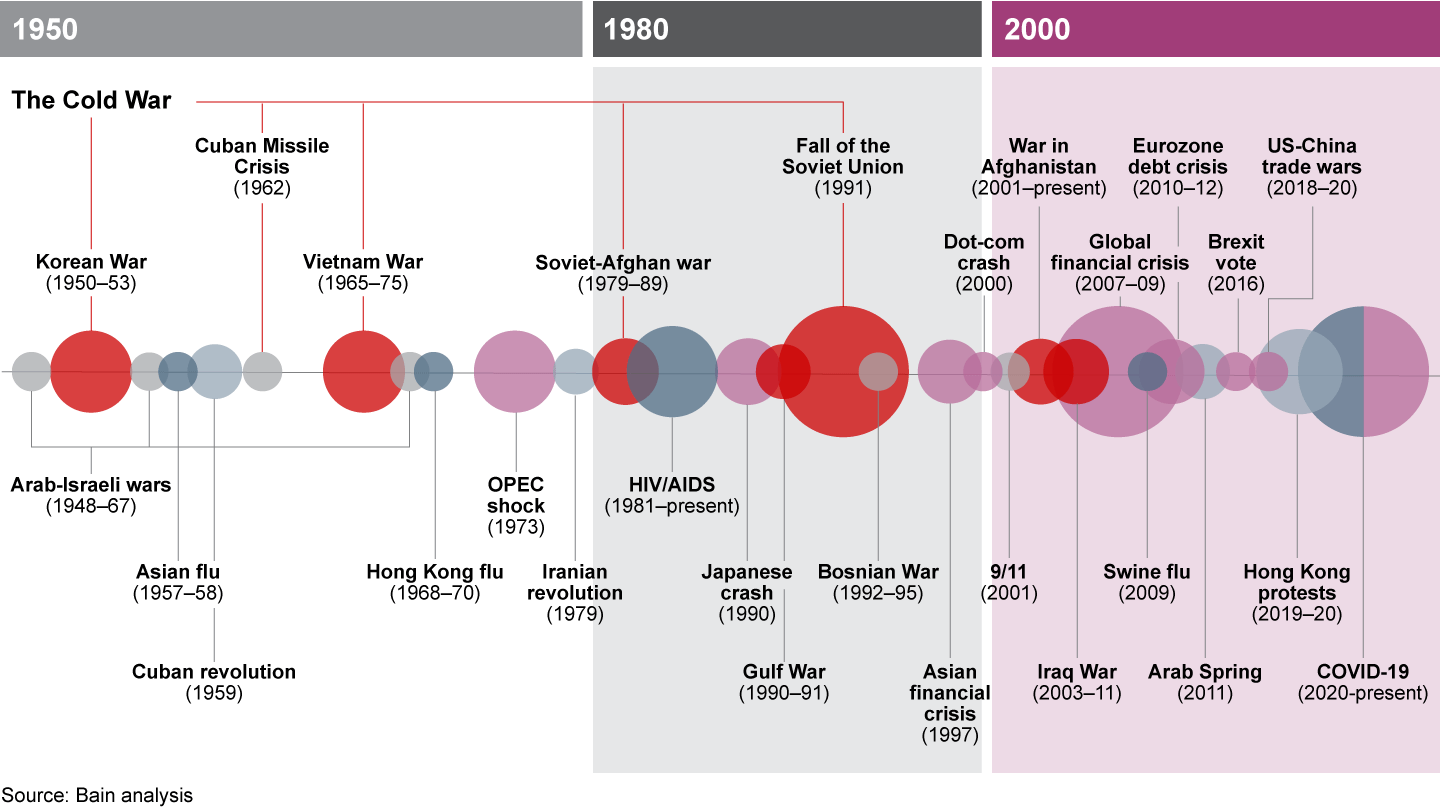
In China, companies have come to expect turbulence in a variety of forms:
- Interstate conflict
- Civil conflicts and rebellions
- Public health and environmental threats
- Financial crises and trade conflicts
- Technological disruption and threats
We found that the top perceived risks to doing business in Greater China in 2020 fell into four specific categories.
- Asset bubbles. With the global financial system already outsized relative to underlying economies, asset inflation is pushing up the investment risk curve. Commodity-linked business are especially vulnerable.
- The spread of infectious diseases. Although Covid-19 is the obvious and immediate concern, Hong Kong and mainland China companies have also dealt with a spate of other epidemics, including bird flu A(H5N1) and SARS-CoV-2. And scientific experts warn that future epidemics are a matter of when, not if.
- Interstate and civil conflicts. Like the rest of the world, Hong Kong and mainland China companies must navigate the threats of war, terrorism, and border conflicts on supply chains, investors and customers. Closer to home, Hong Kong’s recent demonstrations and social unrest are a particular concern.
- Natural catastrophes. Natural disasters threaten major damage to property and infrastructure. Earthquakes, floods and typhoons, drought, landslides, hailstorms, and fires have all affected the region over the past few decades.
Such turbulence is likely to continue and even intensify in the future. More than 90% of our survey respondents expect more turbulence in the business environment in the coming three to five years. Large corporations with regional or global business footprints expect even more intense risks.
“We have faced a lot of turbulence during the past 15 years,” noted the company secretary of a leading electronics company. “Given the current global supply chain and business, any global problem is potentially our problem too.”
More than 90% of surveyed company secretaries expect businesses to experience growing turbulence in the next 3 to 5 years.
Other simmering disruptions might be less urgent in the short term, but still demand attention.
- Future customers. Customer needs are increasingly fragmented as personalization—powered by new technologies and access to data—emerges in multiple industries. Rising income inequalities create competing desires for premium products on one end of the spectrum and value on the other. Growing eco-consciousness and a focus on health and well-being demand sustainably marketed products. Companies must find new ways to meet new diverse customer expectations. Generic customer segmentation simply won’t suffice.
- Emerging and new business models. In addition, companies are seeing the emergence of competing business models. For example, mobile payment methods, including WeChat Pay and AliPay, pose a threat to traditional payment methods.
- Advancement in capabilities. Advances in data analytics are giving rise to other technological disruptions, including the partnering of retailers and big tech, increasing automation, and AI-transformed value chains.
Despite their acknowledgement of increasing risk and disruption, Hong Kong and mainland China companies are generally confident about their ability to manage turbulence and thrive in uncertainty. Three elements are critical to such efforts.
- Prediction. Company leaders must be able to predict and assess risk and change. The vast majority of company secretaries agree or strongly agree that their companies do well in this regard.
- Adaptability. In response to anticipated turbulence, companies must be able to adapt with future-proof strategies and the right talent. Again, more than four out of five company secretaries are confident in their companies’ ability to adapt.
- Resilience. When unanticipated shocks do occur, companies must have the capacity to recover from them and survive. Most surveyed secretaries agreed or strongly agreed that their companies were resilient to shocks.
The only area in which confidence in the ability to manage change fell below 80% was a future-proof strategy to accommodate various scenarios. Although three-quarters of respondents were confident in this capability, this earmarks an opportunity for both boards and company secretaries.
The key to surviving disruption: Stakeholder management
Amid this growing turbulence, an unmistakable opportunity has become apparent. Company secretaries strongly agree that board directors who discuss stakeholder management—balancing the concerns of shareholders with those of employees, customers, suppliers, governments, regulators, and communities more broadly—manage turbulence more effectively across all dimensions (see Figure 2).
- Better at predicting and assessing risk. Boards that already discuss stakeholder management were rated 3.0 times more likely to understand the origins and signposts of change and 2.4 times more capable of understanding both the risks and opportunities related to such change.
- Better at adapting via a future-back strategy. Company secretaries at organizations with stakeholder-focused boards were 3.7 times more likely to see the development of future-back strategies and 3.3 times more likely to see their companies as agile and ready to pivot.
- More resilient to shocks. At companies that discussed stakeholder management, company secretaries were 2.8 times more likely to say that the company was ready to bounce back from shocks.

Overall, more than 90% of company secretaries in Hong Kong believe stakeholder management helps to deliver better financial results for their companies.
More than 90% of surveyed company secretaries in Hong Kong believe stakeholder management helps to deliver better financial results. “Our board take the interest of stakeholders seriously and we require our operating companies to do so as well,” noted the secretary of a leading conglomerate. “You have to realize that if stakeholders prosper, so do we as a company."
However, only half the boards of surveyed companies have discussed stakeholder engagement and management (see Figure 3). Hong Kong and mainland China companies have room to improve stakeholder management—and thus their overall resilience to turbulence. Boards that haven’t yet begun to discuss such matters would be well advised to pick up the pace; fewer than half of them currently plan to increase their focus on stakeholders. Boards that have joined the discussion see the value in it, as three-quarters of them intend to increase that focus.
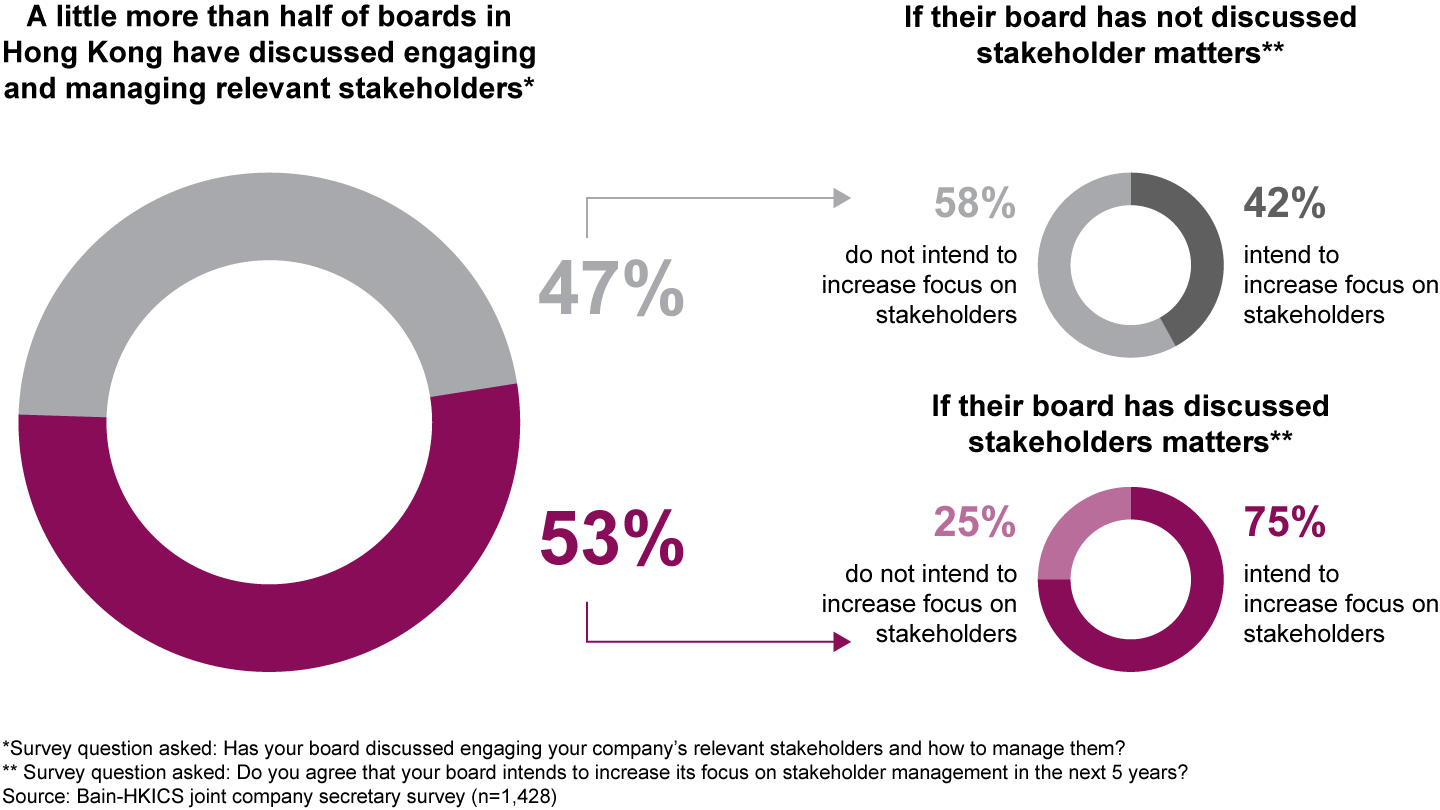
There’s room for improvement. Our survey found that fewer than one-quarter of boards regularly discuss stakeholder issues, as opposed tothree-quarters that regularly discuss strategy development, review, and approval. Fortunately, some have taken the first step: 20% of surveyed company secretaries strongly agree that their boards have identified relevant stakeholders and the issues that concern them. However, only half as many believe that their boards have achieved the right balance between stakeholder and shareholder interests.
Company secretaries from leading firms recognize the positive impacts of effective stakeholder management. “When we actively and effectively address stakeholders, we are more financially stable and sustainable,” noted a representative from a leading transportation company. “This allows us to reinvest in infrastructure and maintain superior services.”
How can companies benefit from stakeholder management? A few companies in China illustrate the potential.
- Walmart China responded to the needs of its suppliers and community members by providing tools and training to help more than 800 factories identify energy-efficient projects. As a result, the company has saved about $40 million in energy costs.
- Haidilao Hot Pot offered employees competitive compensation packages and maintains special reserves to support employees during personal emergencies. The company has also committed to promoting from within its ranks. In turn, Haidilao’s retention rate is more than 90% for frontline workers and more than 95% for management, compared with about a 60% retention rate for the industry.
- One leading utility company worked with government and regulatory stakeholders to develop its natural gas business to replace coal usage in rural areas in response to China’s Blue Sky Project antipollution initiative. Over the following two to three years, the organization gained significant market share.
Identifying stakeholders and responding to their needs and priorities clearly presents an opportunity for Hong Kong and mainland China companies to effectively grow, even in times of disruption.
The new board agenda
As noted earlier, most board meetings in Hong Kong and China currently focus first on the firm’s strategy, with business-environment risks and opportunities second (see Figure 4). Introducing a new board agenda can enable boards to increase their focus on stakeholder management and thus help their firms address issues of increasing turbulence (see Figure 5).
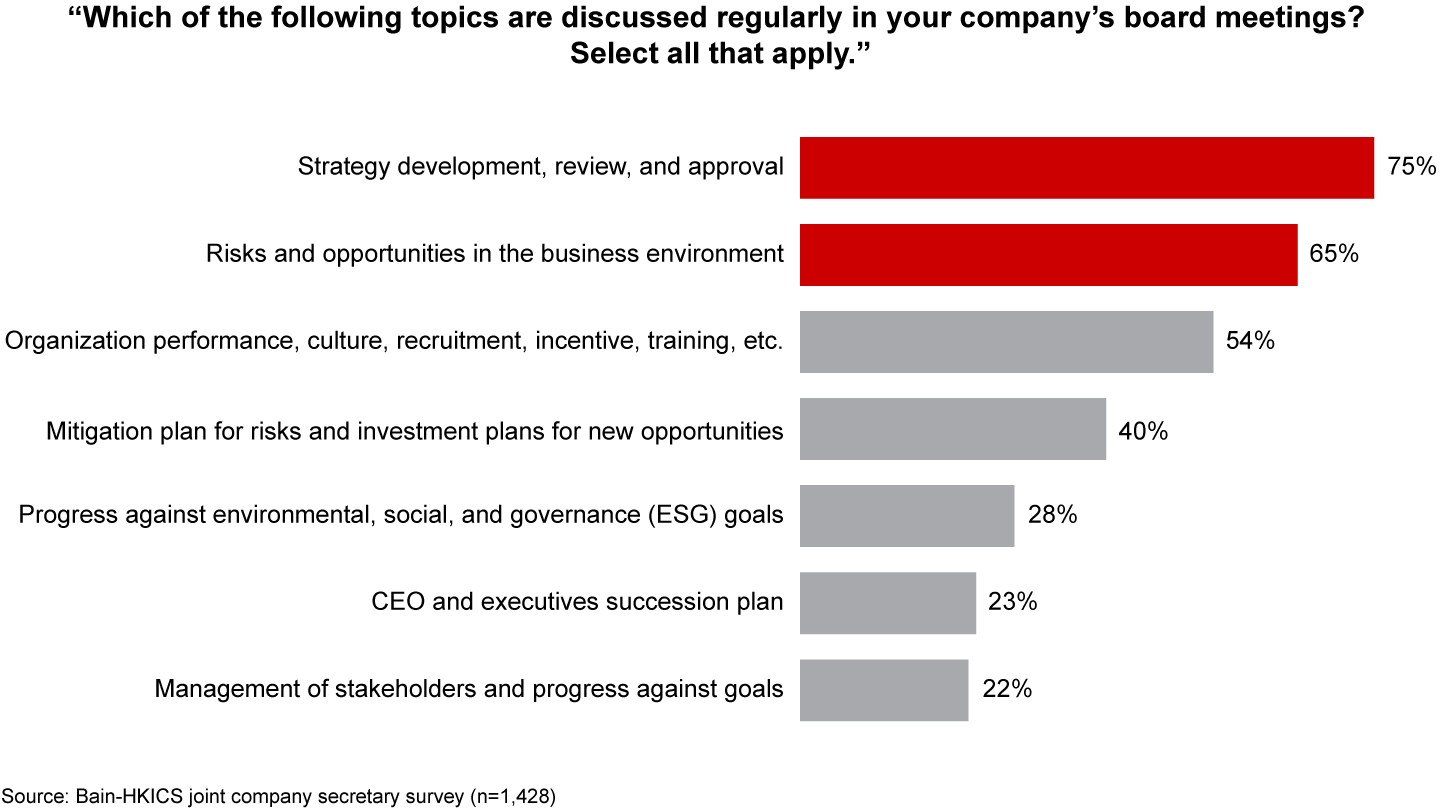
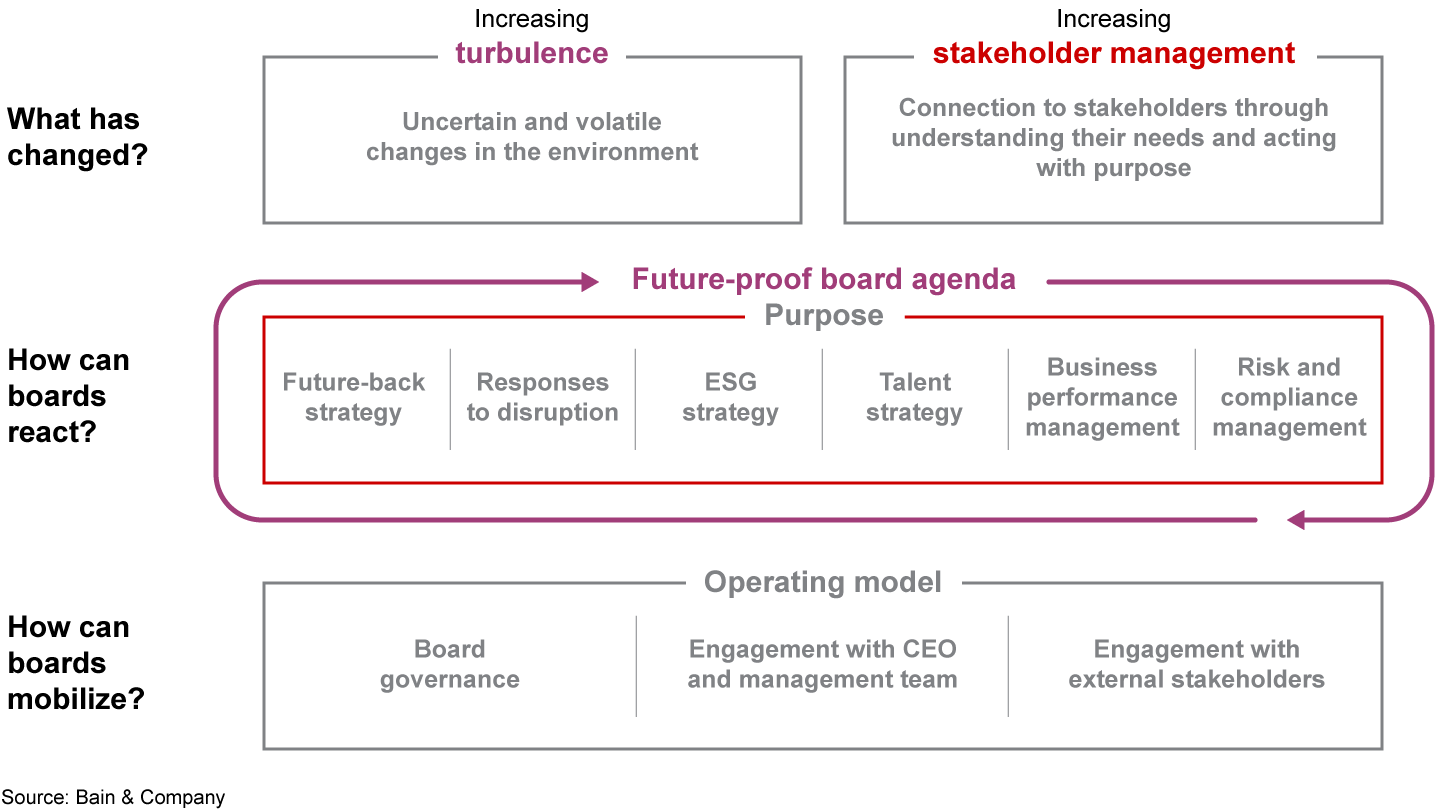
What does a future-proof agenda look like? We suggest the new board agenda should include seven main topics.
- Purpose. Clearly define the company’s long-term purpose: its reason for existence and how it benefits both stakeholders and society. A well-defined, multigenerational purpose is a beacon by which the company can navigate turbulent times and encompasses the remaining topics.
- A future-proof strategy. By focusing on the few uncertainties that matter most to stakeholders, boards can begin to develop a vision for potential futures that address those concerns. They can then build a portfolio of no-regrets moves, options, and bets. For example, one global steel company developed a “strategy in uncertainty” approach—including the review of uncertainty factors, definition of market-evolution scenarios, and identification of a portfolio of strategic initiatives—to implement strategic planning for multiple market scenarios.
- Response to disruption. Boards can identify opportunities to win by considering how to respond to potential disruptions, including future customers, ecosystem evolutions, data analytics, new capabilities, and emerging competition. One example: A leading global sportswear player that expected to face several disruptions in China used a future-back approach to identify the four scenarios most likely to take shape as early as 2025, then developed eight transformative moves to win in those scenarios.
- Environmental, social, and corporate governance (ESG) strategy. By ensuring regular discussion of ESG, boards can sustainably accelerate the company’s core strategy, setting specific goals with clear action plans, and addressing evolving issues and opportunities. A global agribusiness company announced a core purpose centered on sustainability. To help ensure progress, the company built a digital platform that monitors performance indicators, evaluates risks, and triggers action plans.
- Talent strategy. The best talent strategy ensures that the right talent is in the right roles at the right time by assessing talent gaps and identifying key talent requirements. Successful strategies also include guidelines for mobilizing talent, and clear succession plans. One Chinese shipping company identified critical barriers to its growth strategy, then developed an HR strategy to meet business-unit needs, design performance metrics, and integrate a talent-management program.
- Business performance management. Boards can build financial strength to fuel growth and innovation by achieving commercial and operational excellence through cost transformation, agile corporate support, procurement optimization, and supply-chain resilience. For example, a global grocery retailer reprioritized its fresh foods account in China and achieved a 5% to 10% growth in sales and a 5% to 6% reduction in purchase costs.
- Risk and compliance management. A clean-sheet approach to compliance and risk identification reexamines the root causes of compliance failure and organizational complexity and identifies which activities are truly needed, who should perform them, and how they should be performed. It also eliminates nonessential tasks, thus reducing complexity and risk. An example: A global payment company created a three-year compliance strategy that reduced spending about 15% simply by establishing cross-functional teams to look at critical compliance processes and identify process improvements based on root-cause analysis.
The takeaway for corporate boards? Successful implementation of this new agenda requires three types of board mobilization.
- First, boards must address their governance: meeting format and frequency, committee structures, agenda design, and so on. In addition to mandatory board committees (such as audit, remuneration, and risk management committees), we have observed that several boards around the globe have also established strategy committees and ESG or sustainability committees.
- Second, boards must engage with senior management and work alongside them to encourage a shift in focus and action. Board leaders and senior management must align on key interactions not just during, but also outside, board meetings. Leaders must also agree on the norms and expectations for these interactions to help ensure their effectiveness.
- Third, boards must engage with external stakeholders to fully grasp their concerns and demands. By understanding the diverse priorities of each stakeholder, board leaders and management can more effectively create successful action plans.
The pivotal role of company secretaries
Our survey reveals that company secretaries maintain an extensive understanding of both the value of stakeholder management and their boards’ opportunities to harness that value. Yet only 17% of company secretaries are very involved in proposing topics and shaping board agendas. For the one in six companies that do involve secretaries in proposing board agendas, those boards are more likely to discuss topics that address turbulence and stakeholder management (see Figure 6).
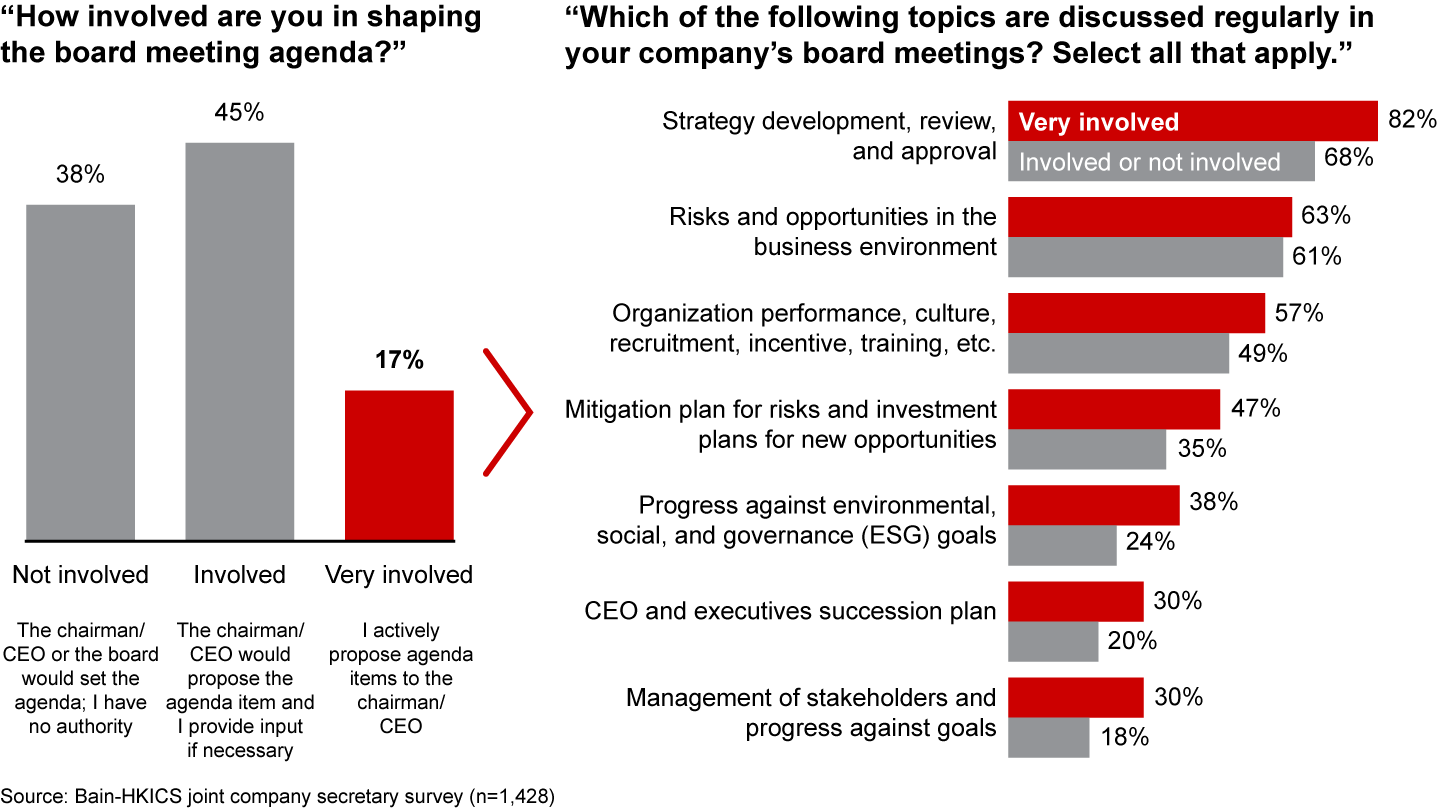
Clearly, company secretaries play a critical role. When secretaries work to ensure that stakeholders are on board members’ minds, those boards increase their involvement in stakeholder management (see Figure 7).
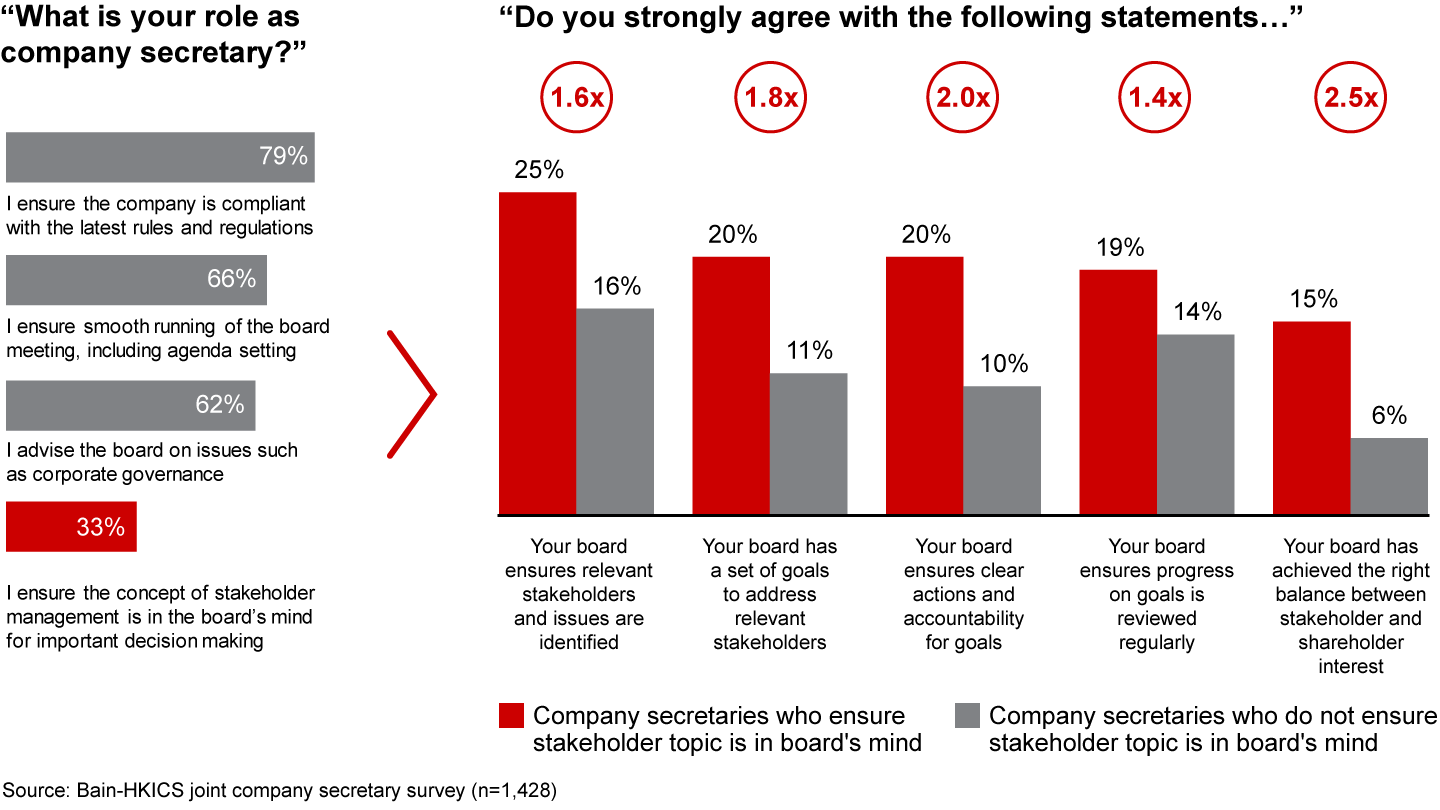
Such boards are more involved in identifying relevant stakeholders, setting goals to address their needs, ensuring clear actions and accountability for achieving those goals, reviewing progress toward the goals and achieving the right balance between stakeholder and shareholder interests.
The takeaway for company secretaries? To increase the firm’s ability to predict, adapt, and be resilient to disruptions in an increasingly turbulent world, company secretaries can begin by closely interacting with relevant stakeholder groups and monitoring signs of emerging change that could affect the industry or business. At a minimum, they can alert board members to stakeholders’ needs and interests. Ideally, they’ll proactively shape the board’s agenda by proposing future-proof topics for discussion and presenting critical issues for review. And they can recognize the long-term value of those agenda items and commit to those that best serve the organization, even when inconvenient in the short term.
Through considered, collaborative action among company secretaries, boards, and company leaders, companies in Hong Kong and mainland China can strengthen their ability to balance the needs of stakeholders and shareholders. In return, they’ll be better prepared to survive—and even thrive—in an environment of increasing disruption.






